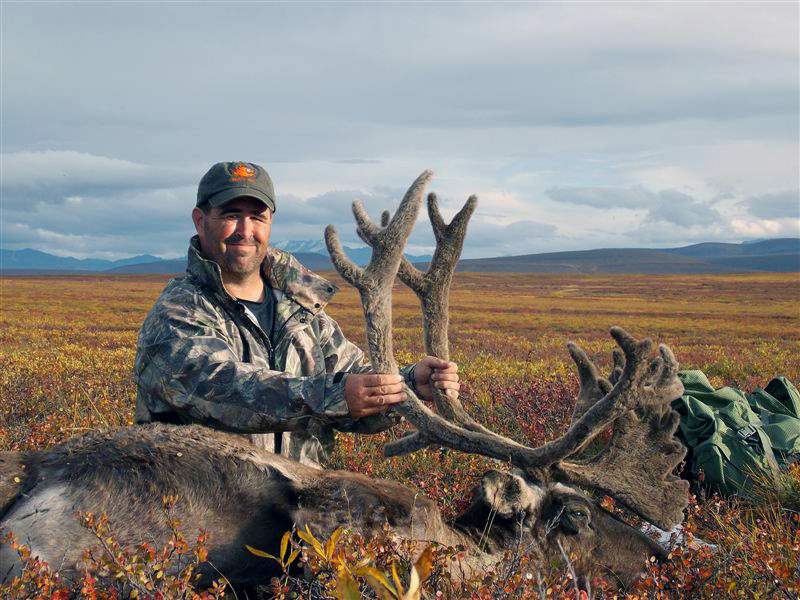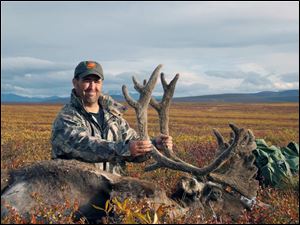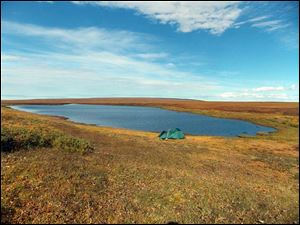
HUNTING OFF THE MAP
Caribou hunting on the Alaskan tundra
11/25/2012
Tim Newlove with trophy caribou.
Photo courtesty of Tim Newlove

Tim Newlove with trophy caribou.
TOOLIK LAKE, Alaska —– Tim Newlove had taken white-tailed deer, elk, and black bear with a bow, and endured a semi-wilderness hunt in the mountains of Colorado.
He was looking for a new challenge, the next adventure. It was time to pursue something more exotic, more difficult, more risky.
How far away is the nearest caribou hunting . . . the real estate appraiser from Bowling Green found out.
He and a long-time hunting buddy went to some of the most remote and rugged terrain on the North American continent, to places that are not even places on most maps, and found caribou . . . along with considerable danger, hardship and the haunting notion that you have left the world behind.
. . “There’s a real feeling of being alone and helpless if anything goes wrong,” Newlove said about the caribou hunt he experienced earlier this fall.
After more than a year of planning, Newlove and Kelly Canter arrived in Fairbanks after a five-and-a-half hour flight from Minneapolis. After gathering camping equipment, a satellite phone, hunting licenses, four-wheel drive truck and extra cans of fuel, it was time to tackle the Dalton Highway, a desolate 414-mile run dead north that would morph from asphalt to gravel to slick dirt. They had a 12-hour drive ahead of them to meet the bush pilot who would fly them into the tundra.
“It is white-knuckle driving,” Newlove said. “You are swerving and fish-tailing, and trying to make sure you stay on a road that has no lines and no guardrails.”

Caribou hunt base camp, above the timberline .
There are no cities, no gift shops, and an hour can pass without seeing another vehicle. They left the tree line at close to 5,000 feet in the Brooks Range, and entered the Arctic watershed.
It’s after midnight when they reach their pilot’s outpost. It’s dark just four or five hours this far north, and they wake to a barren but breathtaking landscape.
“It almost looked like a desert,” Newlove said.
They are flown into the bush and dropped near a small lake where they set up a primitive camp. At four the next morning, there are caribou 100 yards away, but not the mature and heavily-antlered bulls they seek.
The pair sets out for a small valley they had spotted on the flight in, thinking it was close. It takes two hours with full packs to traverse the knee-high, spongy tundra that Newlove described as “bowling balls of wet grass”.
After reaching the valley, hours pass before Canter takes a nice bull. It takes another hour to reach the downed caribou. By the time they skin, field dress and quarter the bull, it starts to get dark.
On the arduous return hike to camp, an exhausted Newlove stops to rest while Canter presses on. When Newlove wakes with the sun and returns to camp, there’s no sign of Canter. Hiking in the dark, he apparently missed the small tent at the edge of a lake.
Newlove unloads his gear and starts a series of one-mile hikes in every direction, using his field glasses to search for his missing friend. Just as Newlove is ready to use the satellite phone to call for a search and rescue plane, Canter returns and the rest of the day is spent recovering from the ordeal
“He knew as soon as it got light that he was lost,” Newlove said.
It takes four trips to pack out all of the meat from Canter’s caribou, and after Newlove takes a nice bull with a 200-yard shot, there is more field-dressing and transporting to do.
The following day, Newlove sees a grizzly bear up on its hind legs and staring at the campsite, apparently locked in on the scent of the caribou meat, but the bear moves on without incident.
With temperatures close to 70 a couple of days, they phone the pilot to come pick up the meat before it spoils. Other days the high was in the 40’s, with frost at night. Several days, the bugs were so bad the pair had to wear headnets.
“You would look down at your hands and they would be covered in black flies,” Newlove said. “Repellant doesn’t seem to work.”
By the end of their eight-day odyssey, both men have taken their two-caribou limit. The pilot says he will be there at noon to ferry them out of the bush. He shows up at 7 p.m.
The trip was relentlessly demanding, but also the bold type of gambit the 41-year-old Newlove was looking for.
“It was incredibly difficult – I lost 20 pounds in nine days. My feet were sore and numb for a long time,” Newlove said. “At first, I was hesitant to say I’d go back, but now I’d go in a heartbeat. It was the most rewarding trip I’ve been on. I figure you have to push it, and always look for more adventure."